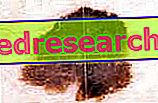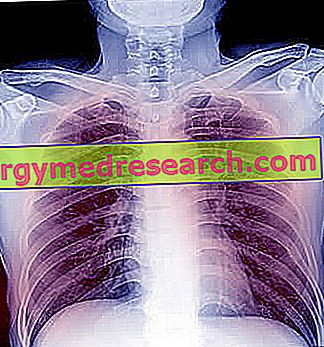Generality
Heberden nodules are particular bony swellings that develop between the distal interphalangeal joints of the hands affected by arthritis.
The distal interphalangeal joints are those articular elements interposed between the second and third phalanges of the fingers.

Heberden's Nodules - Image from en.wikipedia.org
The presence of Heberden's nodules may be responsible for various disorders, including: pain in bending of the fingers, loss of mobility, joint stiffness and swelling.
Unfortunately, at the present time, there are no specific treatments against Heberden nodules, but only symptomatic remedies.
Brief reference to the definition of arthritis
With the term " arthritis ", doctors indicate any inflammatory process involving one or more joints .
The joints are anatomical structures that put two or more bones in mutual contact and are fundamental for the support and mobility functions of the human skeleton.
What are Heberden nodules?
Heberden nodules are characteristic bone swellings that form between the distal interphalangeal joints of the hands of people suffering from arthritis .
From the clinical point of view, they are an important indicator of how much the aforementioned joints are damaged and / or altered compared to normal.
Note : in order to better understand the exact position of the distal interphalangeal joints and the anatomy of the hand, readers can consult the article present here.
ARE OSTEOFITHS
Heberden nodules are a particular type of osteophytes .
Osteophytes (or bone spurs) are small bony projections - most often similar to a thorn of a rose, a beak or a claw - that develop along the articular edges of bones subjected to erosive and irritative processes with a chronic character.
ORIGIN OF THE NAME
The Heberden nodules owe their name to those who first described them and associated them with the presence of arthritis: the English doctor named William Heberden, who lived between 1710 and 1801.
COMPLAINTS WITH OTHER NODULES
From different points of view, the Heberden nodules resemble other bony swellings that are formed in the presence of various forms of arthritis: the so-called Bouchard nodules .
Bouchard's nodules differ from Heberden's nodules in that they locate between the proximal interphalangeal joints of the hands.
Causes
It has been undeniable for some time that Heberden nodules derive from the inflammatory processes that characterize some forms of arthritis.
Among the forms of arthritis that cause the appearance of Heberden nodules, they deserve a special mention:
- Osteoarthritis, which represents the absolute cause;
- Rheumatoid arthritis ;
- Gout .
Osteoarthritis or arthrosis: the main information
Osteoarthritis, or more simply osteoarthritis, is the most common type of arthritis in the general population.
The inflammation that characterizes osteoarthritis derives from the deterioration of the cartilaginous layer that covers the bony surfaces involved in the affected joint (s) (NB: the correct name of these surfaces is articular surfaces).
Osteoarthritis risk factors are different; among the most important, special mention should be made: advanced age, belonging to the female sex, joint injuries and obesity.
Osteoarthritis can affect any joint; however, it has a particular predilection for the joints of the hands, knees, hips and joints of the spine.
Some of the typical symptoms and signs of arthrosis are: pain, joint stiffness, swelling, reduced ability to move and presence of osteophytes.
Unfortunately, there is no specific cure for osteoarthritis; there are only symptomatic treatments, that is aimed at reducing the symptomatology in progress.
HOW DO YOU FORM IN THE CASE OF OSTEOARTHRITIS?
Several research groups have tried to clarify why Heberden nodules form in the presence of osteoarthritis.
According to the most reliable theories, Heberden's nodules are the result of processes of bone regeneration, which take place where the cartilage of the distal interphalangeal joints is now completely degenerate (therefore non-existent).
Heberden nodules are to be considered a typical clinical sign of advanced osteoarthritis, as they appear when the articular cartilage layer is completely absent.
RISK FACTORS
According to several clinical studies, people with:
- Osteoarthritis. It is by far the main risk factor of Heberden nodules;
- Rheumatoid arthritis. Inflammation of the joints has an autoimmune origin, that is, it arises due to a malfunction of the immune system.
- Gout. It is a metabolic disease which, among the various possible consequences, also determines the deposition of urates in the articular cartilages; these urates are responsible for an inflammatory state affecting the joints involved;
- Conditions affecting the good health of articular cartilage (chondropathies);
- Joint malformations resulting from hereditary diseases. They involve a small proportion of individuals with Heberden nodules.
Symptoms, signs and complications
Heberden nodules are easily recognizable to the naked eye, as they appear as swellings interposed between the second and third phalanx of the fingers (which is then the seat of the distal interphalangeal joint). In the most serious cases, they extend almost to the nails and induce a wrinkling of the fingers.
The symptoms and signs that accompany Heberden's nodules are:
- Loss of mobility by the joints of the hands;
- Pain when bending the fingers;
- Swelling;
- Sense of rigidity at the level where the nodules are located.
REPERCUSSIONS IN THE LIFE OF EVERY DAY
He who suffers from Heberden nodules has obvious difficulties in holding or tightening objects.
This has many consequences in everyday life, from turning the car key to uncorking a bottle.
For some patients, the fact that they are no longer able to perform simple and banal gestures - such as those mentioned above - is the cause of episodes of depression and anxiety .
Diagnosis
In general, for a correct diagnosis of Heberden nodules, physical examination and history are sufficient.
The use of diagnostic imaging tests (X-rays, etc.) takes place only in doubtful situations or when it is necessary to study in detail the extent of joint damage (in particular cartilage).
Therapy
Unfortunately, at present the Heberden nodules represent a condition for which there are no specific treatments, but only symptomatic treatments . In other words, it is impossible to cure and eliminate Heberden's nodules (restoring normal joint anatomy), but it is possible to alleviate the symptoms.
Briefly, the main purposes of symptomatic treatments for Heberden nodules are:
- Reduce pain during finger bending;
- Restore part of the joint mobility of the fingers.
CONSERVATIVE TREATMENT
Premise: in this section and in the following one, the attentions are turned above all to the Heberden nodules due to a state of osteoarthritis, since the latter represents the most important cause.
The list of typical conservative treatments for Heberden nodules includes:
- The constant practice of physical exercise . The entire medical community agrees that the main therapeutic (and even preventive) remedy against osteoarthritis is constant movement and physical activity;
- Physiotherapy, for lengthening ligaments and hand muscles;
- A dietary program aimed at reducing body weight . This remedy is clearly indicated for overweight or obese patients;
- The administration of non-steroidal anti-inflammatory drugs (NSAIDs). Among the NSAIDs, those most commonly prescribed for Heberden nodules are aspirin, ibuprofen and selective COX-2 inhibitors.
SURGICAL TREATMENT
Surgery is used only in extreme cases and only after all conservative treatments have been completely ineffective. In general, therefore, it is a very remote hypothesis.
There are different types of surgery:
- The reconstruction of the joint;
- The fusion of the bony portions involved in the interphalangeal joints ( arthrodesis of the fingers);
- Removal of excess bone tissue and which constitutes Heberden's nodules.



